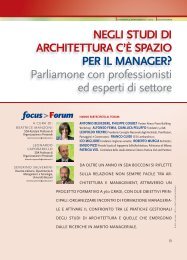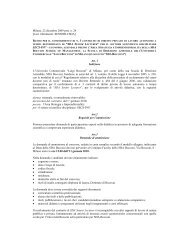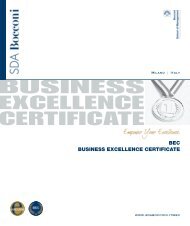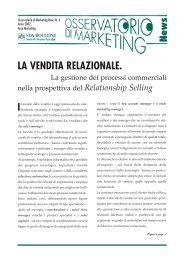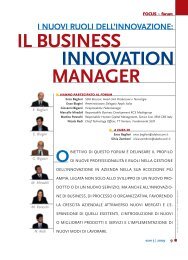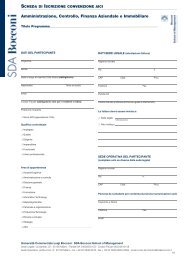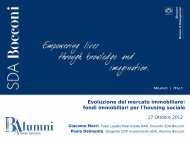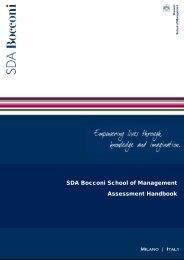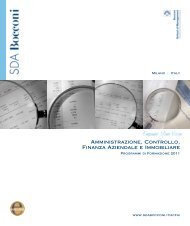Download Document - SDA Bocconi
Download Document - SDA Bocconi
Download Document - SDA Bocconi
- No tags were found...
Create successful ePaper yourself
Turn your PDF publications into a flip-book with our unique Google optimized e-Paper software.
An introductory guide to AACSB AoL(Assurance of Learning) at <strong>SDA</strong> <strong>Bocconi</strong>M.Brusoni – P.EgiMarch 2012Copyright <strong>SDA</strong> <strong>Bocconi</strong>Index• <strong>SDA</strong> <strong>Bocconi</strong>AACSB Accreditation Process• Assurance of Learning - AoL Process• <strong>SDA</strong> <strong>Bocconi</strong> Learning Goals• <strong>SDA</strong> <strong>Bocconi</strong> AoL CYCLE• Who does what• <strong>SDA</strong> <strong>Bocconi</strong> AoL MantraCopyright <strong>SDA</strong> <strong>Bocconi</strong> 2
<strong>SDA</strong> <strong>Bocconi</strong> AACSB AccreditationProcessCopyright <strong>SDA</strong> <strong>Bocconi</strong> 3<strong>SDA</strong> <strong>Bocconi</strong>AACSB Accreditation ProcessSubmission of the Eligibility ApplicationThe Pre-Accreditation Committee assigns a mentor who visits <strong>SDA</strong> <strong>Bocconi</strong>Submission of <strong>SDA</strong> <strong>Bocconi</strong> Accreditation PlanThe Initial Accreditation Committee approves the Accreditation Plan5 years(on ave erage)Submission of the Annual Report under the mentor supervisionUpdate of AoL ReportsThe Initial Accreditation phase startsSubmission of <strong>SDA</strong> <strong>Bocconi</strong> Letter of application for initial accreditation with the date proposal forthe site visitThe IAC appoints the PRT Chair who works with the School to prepare the Self-Evaluation ReportThe PRT Chair visits <strong>SDA</strong> <strong>Bocconi</strong>Submission of the SER Self Evaluation ReportPeer Review Team site visitThe AACSB International Board of Directors ratifies the AACSB Initial Accreditation of <strong>SDA</strong> <strong>Bocconi</strong>School of ManagementCopyright <strong>SDA</strong> <strong>Bocconi</strong>
Mission (revised in 2010)The <strong>SDA</strong> <strong>Bocconi</strong> Mission is:To contribute to the development of individuals andorganizations by creating and disseminatinginnovative managerial knowledge“Empowering lives through knowledge andimagination”Copyright <strong>SDA</strong> <strong>Bocconi</strong>Key elements related to the MissionStrategic planProgram portfolioFaculty ManagementResearch and Intellectual Contributions(data base and monitoring)AoL – Assurance of LearningCopyright <strong>SDA</strong> <strong>Bocconi</strong>
AACSB Business Accreditations Standards• Strategic Management Standards (1-5)A school articulates its mission and action items as a guide to its view of the future, planned evolution,infrastructure, and use of resources. The AACSB Accreditation review process is linked to a school’s mission.The strategic management standards verify that a school focuses its resources and efforts toward a definedmission as embodied in a mission statement.• Participants Standards (6-14)A direct link exists between a school’s mission, the characteristics of students served by the educationalprograms, the composition and qualifications of the faculty members providing the programs, and the overallquality of the school. Therefore, these standards focus on maintaining a mix of both student and facultyparticipants that achieve high quality in the activities that support the school’s mission.• Assurance of learning Standards (15-21)Student learning is the central activity of higher education. Definition of learning expectations and assurance thatgraduates achieve learning expectations are key features of any academic program. The learning expectationsderive from a balance of internal and external contributions to the definition of educational goals. Members of thebusiness community, students, and faculty members each contribute valuable perspectives on the needs ofgraduates. Learning goals should be set and revised at a level that encourages continuous improvement ineducational programs.Copyright <strong>SDA</strong> <strong>Bocconi</strong> 7Assurance of Learning – AoL ProcessCopyright <strong>SDA</strong> <strong>Bocconi</strong> 8
Assurance of Learning - AoL ProcessStep 1Establish learning goals and objectivesStep 2Alignment of curricula with adopted goalsStep 3Identification of assessment instruments and measuresStep 4Collection, analyzing, and dissemination of assessmentinformationStep 5Using assessment information for continuousimprovement including documentation that the processis being carried out on an ongoing, systematic basisCopyright <strong>SDA</strong> <strong>Bocconi</strong> 9What is Assurance of Learning?Assurance of learning is a regular, systematic, and sustainablemechanism that t assures that t predetermined d learning goals and learningexperiences are occurring.Why is Assurance of Learning Important?Helps to determine whether the School’s mission has beenaccomplished.Provides a rationale for modifying existing curriculum and instructionalmethods.Enables the School to examine student growth and satisfaction.Copyright <strong>SDA</strong> <strong>Bocconi</strong>
Learning Goals and Learning ObjectivesGoals express what the School wants its students to beObjectives describe what the School wants its students to doThe definition of learning ggoals is a key element in how the school definesitself. This implies thatthe learning goals are closely related and connected tothe School and the program’s missionCopyright <strong>SDA</strong> <strong>Bocconi</strong>Assessment vs. EvaluationGrades, when used alone, are no longer regarded as adequateindicators of student t learningAssessment focuses on the student and the learning environmentEvaluation focuses on the professor and the teaching performanceCourse grades are not program assessment measuresCopyright <strong>SDA</strong> <strong>Bocconi</strong> 12
What is Program-Level Assessment asspecified by AACSBDeep learning is a curriculum function. It is not a course function.AACSB states that the School must specify and assess learninggoals for each degree program.Copyright <strong>SDA</strong> <strong>Bocconi</strong> 13Some Assessment Ways and MeansDIRECT ASSESSMENTacquires evidence about studentlearning and the learningenvironment• Course embeddedmeasurement• Case studies• Classroom assignments• Oral presentations• Simulations• Business Plan• Stand-alone measurement• Thesis or final project• Stand-alone examinations at theend of the program• Final assignmentsINDIRECT ASSESSMENTacquires evidence about howstudents feel about learning andtheir learning environment• Employers, Alumni,Students• Surveys• Interviews• Questionnaires• Focus Groupmay be part of anassessment program,but alone are notsufficientCopyright <strong>SDA</strong> <strong>Bocconi</strong> 14
Grading and Assessing:Critical Thinking in a Speaking EnvironmentTraits: 3 2 1Critical Thinking1. Identifying _x_ ___ ___2. Exploring ___ _x_ ___3. Prioritizing ___ _x_ ___4. Revisioning ___ ___ _x_Speaking5. Voice and pace _x_ ___ ___6. Body language, mannerisms ___ ___ _x_7. Professionalism, audience awareness ___ _x_ ___8. Use of media ___ _x_ ___9. Handling of questions _x_ ___ ___Score = 19Scoring:27-23 Exceeds expectations22-16 Meets expectations15- 9 Does not meet expectations Copyright © 2009Copyright <strong>SDA</strong> <strong>Bocconi</strong>Douglas J. EderGrading and Assessing:Critical Thinking in a Speaking Environment:Traits: 3 2 1Critical Thinking1. Identifying 12 13 52. Exploring 11 15 43. Prioritizing 8 16 64. Revisioning 3 12 15Speaking5. Voice and pace 22 5 36. Body language, mannerisms 14 12 47. Professionalism, audience awareness 16 9 58. Use of media 4 15 119. Handling of questions 6 16 8[Mean score = 19.2 or 2.1 / 3 2.8 / 4]QUESTION: What part(s) of the curriculumdeserves special attention?Copyright <strong>SDA</strong> <strong>Bocconi</strong>Copyright © 2009Douglas J. Eder
<strong>SDA</strong> <strong>Bocconi</strong> Learning GoalsCopyright <strong>SDA</strong> <strong>Bocconi</strong> 17<strong>SDA</strong> <strong>Bocconi</strong> Learning GoalsThe three dimensions and the related Learning Goals are the following:DimensionMANAGEMENTKNOWLEDGE12Learning GoalManagement KnowledgeGraduates will be competent in the core functional areas and understand how theseareas are integrated.Entrepreneurial mindset and creativityGraduates will acquire an entrepreneurial and creative mindset.Diversity and global business issuesENVIRONMENT 3 Graduates will understand the impact of diversity on organizations, and will have anunderstanding of the main global issues affecting companies, public/non-profitorganizations, banks and financial institutions.Ethics & Integrity4Graduates will be conscious of the needs to comply with rules, regulations, social norms.Strategic Thinking & Problem Solving Skills5 Graduates will formulate effective strategies and make decisions, using problem solvingtechniques.Teamwork & Leadership SkillsMANAGEMENTSKILLS6 Graduates will work effectively in teams, using interpersonal, communication and leadershipskills.Project Management Skills7 Graduates will be able to effectively plan and implement projects and activities and tocoordinate tasks and monitor their progress.Copyright <strong>SDA</strong> <strong>Bocconi</strong>
<strong>SDA</strong> <strong>Bocconi</strong> AoL CycleCopyright <strong>SDA</strong> <strong>Bocconi</strong> 19<strong>SDA</strong> <strong>Bocconi</strong> AoL CYCLESeptemberBefore the start t ofProgramsAccording to theannual assessmentplanAccording to theProgram calendarand the annualassessment planJune/JulyJulyMasterDivisionDirectorSubmits the AoLcycle results to theManagementBoard StrategicMeetingProgramDirectorSubmits the annualassessment plan tothe MasterCommitteeProgramFacultyProgram Director and Faculty meet toshare the assessment plan andmeasurementsCollects measurementsand documents (tests,exams, assignments,etc.).Carry out theplannedmeasurementsProgram Director and Faculty meet toshare and discuss assessment resultsand actionsSubmits the ProgramDirector Annual Reportto the Master CommitteeAoL TeamSupervises themeasurementscollection and theimplementation ofassessmentresultsInstructions andtemplatesThe Program Director fills in amatrix that highlights the impactof courses on various LGsEach Program Director fills in amatrix that shows which LGs willbe measured, where and whenin accordance with the programcalendar. The templates are preprintedwith LGs/Objectives foreach ProgramTemplate to be filled in by theProgram Faculty for theLGS/Objectives measurementsThe Program Director fills in thetemplateThe Quality, Accreditation andBenchmarking Office and theProgram Directors prepare theannual reportProgram Directors AnnualReport SchemeCLO LOSING THELO OOPCopyright <strong>SDA</strong> <strong>Bocconi</strong>
<strong>SDA</strong> <strong>Bocconi</strong>‘s steps to followAssess and checkthe LGs through assignments, exams, business games, cases, etc.Write a short report concerning student performance.Maintain i examplesof student works, grading rubrics or other examples demonstratingstudent achievement of course objectives.Collect data and share themin a meeting with the Program Faculty talking about continuouslyimproving student learning over time.Close the loopReport data, feedback and curricula intervention (if required) in theProgram Directors Annual Report and discuss them in the July Meetingof the Master Division. Report the data to the Accreditation Officer.Copyright <strong>SDA</strong> <strong>Bocconi</strong> 21Who does whatCopyright <strong>SDA</strong> <strong>Bocconi</strong> 22
What should Faculty do?Agree on the products students should produce and the behaviors theyshould exhibit and agree on specific objectives for the course.Make sure that course objectives are relevant to Program-level LearningGoals.Agree on how best to measure Student Performance on each objectivecontributing to program-level Learning Goals.Depending on the method used to assess a course objective, develop arubric or a method of measurement.Evaluate student performance on the specific objective on three levels:Level 1: FAIR (Did not meet expectations - Limited Accomplishment);Level 2: GOOD (Meet expectations - Some problems needimprovement); po e Level e 3:EXEMPLARY (Meet expectations - Considerableeexpertise shown with Project).Report findings to Program Faculty.Discuss the results and determine any actions to take (if necessary).Copyright <strong>SDA</strong> <strong>Bocconi</strong> 23What should Program Directors, CourseCoordinator and Faculty do?Develop course learning objectives that lead to fulfillment of learninggoals.Collect data from faculty to support or measure student learning(including a representative sample of measurementsdevices/tecniques/assignments to be maintained in the office of thecourse coordinator).Report results to the Master Division Committee.Discuss and act on results obtained.Copyright <strong>SDA</strong> <strong>Bocconi</strong> 24
How many students must meet or exceedthe performance standard?The focus of AACSB-International will be how these data are used forcontinuous improvement purposes. A poor showing of student masterywould only be a concern if course content, delivery or the curriculumwere not modified to improve performance.AACSB also expects that assessment processes will improve overtime. Although faculty must establish their own expectations <strong>SDA</strong><strong>Bocconi</strong> decided that:a satisfactory level of achievement would be having notmore than 30% of students in Level 1 (Fair).Revise thresholds linked to student progression and talentempowermentCopyright <strong>SDA</strong> <strong>Bocconi</strong> 27<strong>SDA</strong> <strong>Bocconi</strong> AoL MantraCopyright <strong>SDA</strong> <strong>Bocconi</strong> 28
Keep it simpleLook for (andadopt) commonLGsOne Issue OneLGSame LGssame objectivessame measuresDifferences mustbeexplained/justifiedClarify andsimplify thewordingCopyright <strong>SDA</strong> <strong>Bocconi</strong>Make it clearDo not assume if it isclear for you it mustbe clear for everyone(Students too)Link actions tooutcomesLink outcomes tomissionCopyright <strong>SDA</strong> <strong>Bocconi</strong>
Measurement tipsExplain the wayyou measure(tools and rubrics)Define commonthresholds (30%Fair as a limit fortaking actions)Adopt also someexternal evaluationConsiderimprovements alsowith acceptableresultsCopyright <strong>SDA</strong> <strong>Bocconi</strong>



